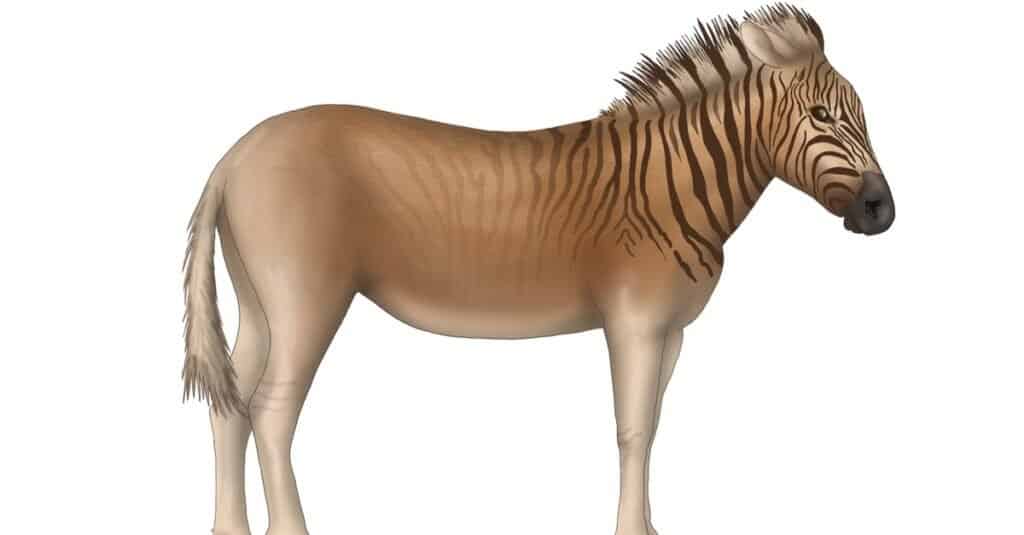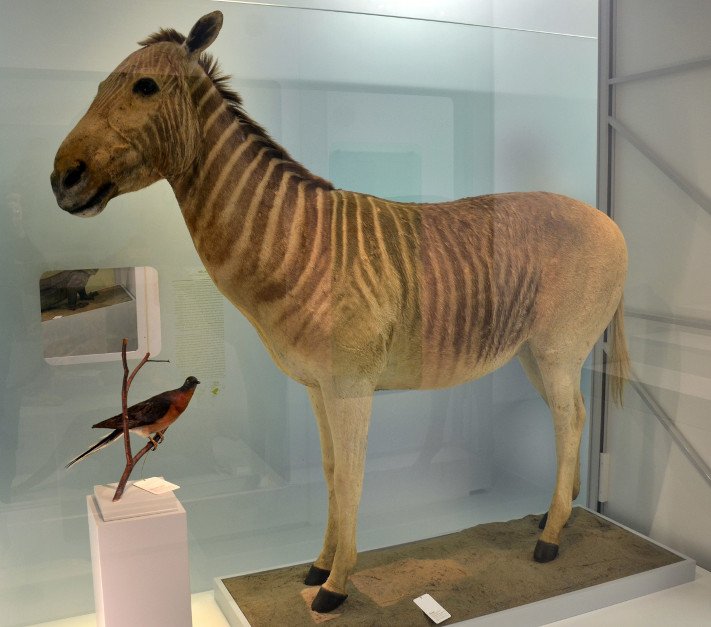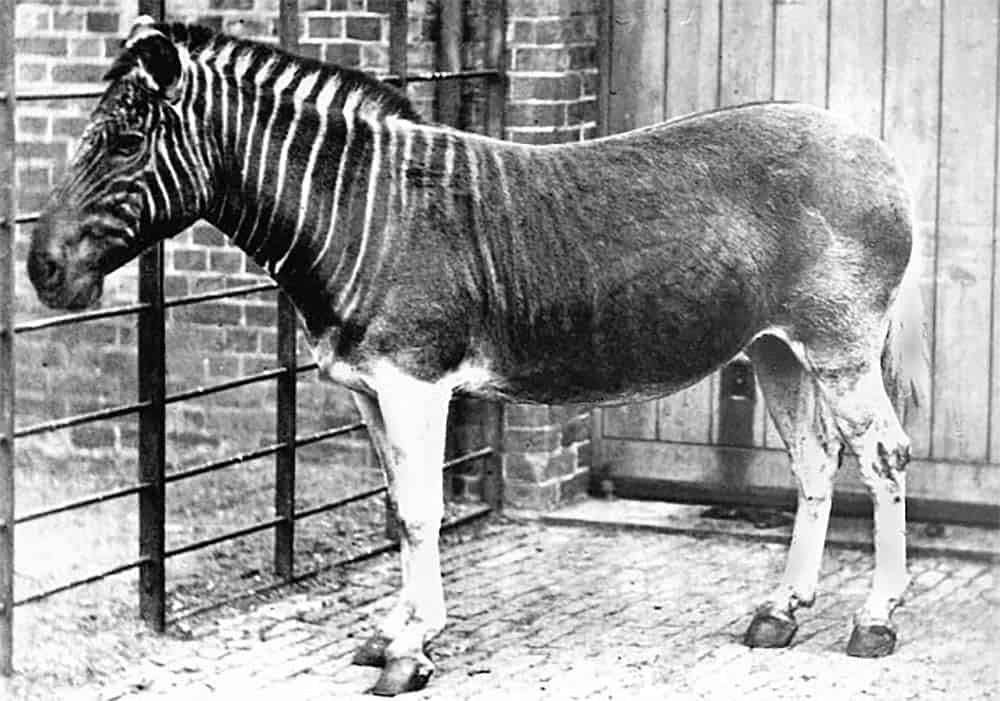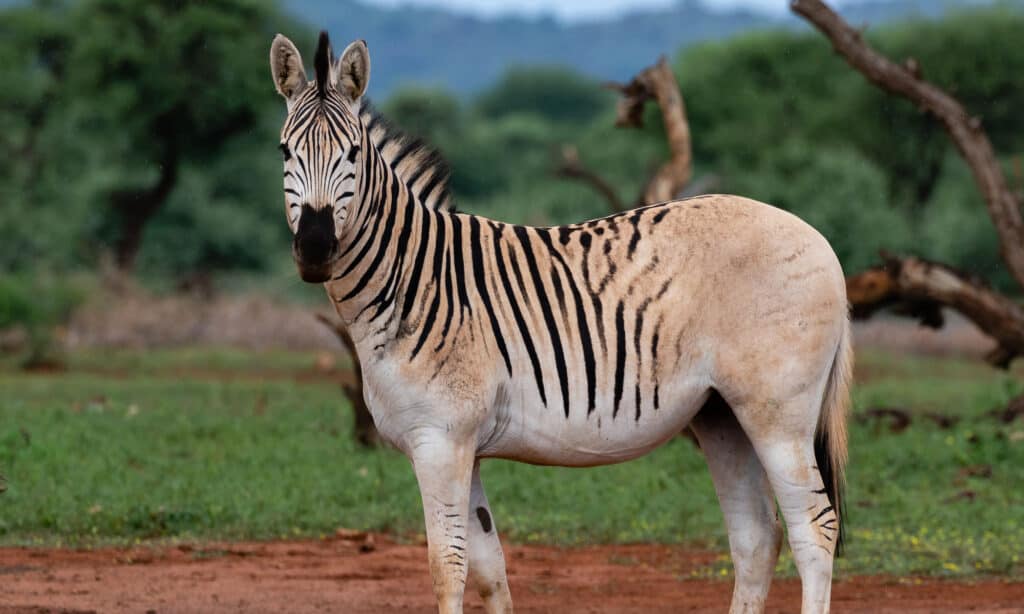A quagga is an extinct subspecies of plains zebra that lived in South Africa in great grassland roaming herds until humans hunted it to extinction for its stripy skin. Read on to find out more about the extinct zebra and discover the story of the quagga.
Spoiler alert – it’s a sad story.
What Is A Quagga?

Quaggas are extinct zebras that lived in South
Africa
until the 1800s.
©miha de/Shutterstock.com
A quagga was a subspecies of plains zebra, but scientists used to think quaggas were a different species.
In 1778, Dutch naturalist Pieter Boddaert classified quaggas as Equus quagga, but it wasn’t until their DNA was studied in 1984 that scientists realized the extinct zebra was actually a subspecies of common zebra.
Quaggas were from the Mammalia class and members of the Equidae family, along with horses and donkeys. They were exclusively herbivores that fed on grasses and other greenery found on the African plains.
What Does A Quagga Look Like?

Twenty-three quaggas are taxidermized and on display in museums.
©Vassil / CC0 1.0 – License
Zebras are stripy across the whole body, but a quagga’s stripes faded below its neck, so there were no stripes on its belly or legs.
Its rear end looked much like a horse, but its head was like a zebra. Most of a quagga’s skin and hair were off-white to brown, and its distinctive stripes were dark brown or black.
Extinct quaggas were strong animals that reached about 257 centimeters (101 inches) in length, and they were roughly 127 centimeters (50 inches) in height. On average, a fully grown quagga weighed about 250-300 kilograms which is the same as a grizzly bear or 100 bowling balls!
Much like today’s zebras, quaggas had long legs with hooves, a mane, and a tail. They could run at speeds of 64 kilometers (40 miles) an hour. They were able to kick predators such as lions with their hard hooves and muscled back legs.
Overall, the distinguishing feature of a quagga was its stripy hair that faded closer to the ground. Unfortunately for the quagga, this unusual skin was attractive to humans who hunted them to extinction, along with their meat.
Twenty-three taxidermized specimens remain if you want to see the extinct zebra and discover the story of the quagga in person. The British Museum, London, and the Peabody Museum, U.S.A., have one each.
A 24th specimen was destroyed during WW2 in Konigsberg, Germany.
Is A Quagga A Zebra?
Yes, a quagga was a zebra. It was a subspecies of plains zebra often called common zebra. If you’ve been on safari or to a zoo, a plains zebra is most likely the type you’ve seen.
There are other zebra subspecies today, including Burchell’s zebra, Chapman’s zebra, Crawshay’s zebra, Grant’s zebra, and the Maneless zebra, but they are not endangered.
How Did The Quagga Go Extinct?

The last quagga died in 1883 in an Amsterdam zoo.
©Frederick York (d. 1903) / public domain – License
European settlers hunted quaggas to extinction in the late 1800s. Hunters killed so many quaggas that they couldn’t reproduce quickly enough to save themselves from extinction.
They have predators, too, such as big cats, but it was human desire for their skin, meat, and pleasure hunting that led to their demise. Settlers also wanted their herds of sheep and cattle to graze on the pasture quaggas ate, so they killed them to stop the competition.
The last wild quagga was killed in 1878 in South Africa’s Free State, and the world’s final quagga died in Amsterdam’s Artis Magistra zoo in August 1883.
How Do You Say Quagga?
Kwag-uh. It’s an onomatopoeia which means an imitation of the sound. When quaggas called, they didn’t neigh or bray; they ‘Kwah-ga-ha!’
Remember to keep the ‘a’ sound short like the ‘a’ in hat, not the ‘a’ in May.
Where Did Quaggas Live?
Quaggas lived in Africa and were native to South Africa, traveling daily in herds throughout Cape Province and Orange Free State. There were a lot of quaggas in the Karoo province of Cape Province, which is a large desert-like area with arid scrubland, savanna, and grasslands for quaggas’ food.
Scientists suggest their limited range made them much more vulnerable to extinction than other zebra species that inhabited more regions of Africa.
However, discovering the story of this extinct zebra is difficult because they were gone before modern science could study them.
Is The Quagga Back From Extinction?

Scientists set up The Quagga Project to bring the extinct quaggas back by selectively breeding zebras that look like quaggas.
©LouisLotterPhotography/Shutterstock.com
In 1987, scientists set up The Quagga Project. Its purpose was to bring the extinct quaggas back by selectively breeding zebras that look like quaggas. It’s been a success in terms of looks. Many of their cross-breeding projects look just like the quaggas, but some scientists disagree, saying whilst the visuals are similar, the hybrids are not true quaggas.
The Quagga Project hopes to breed back a true quagga in the future. They’re not stopping yet!
What Animals Are Scientists Trying To Bring Back?
Scientists are working hard to bring back animals that are now extinct. One example is the woolly mammoth. Woolly mammoths could reach a whopping 11 feet tall and weigh 6 tons! They went extinct 4000 years ago because humans hunted them for their meat and skin. Elephants are the closest living relatives of the woolly mammoth.
Another extinct species under investigation is the infamous dodo. Dodos were hunted to extinction in the 17th century. They lived in Madagascar, and their closest living relative today is the Nicobar pigeon.
Let’s hope scientists stick with extinct mammals and not the T-Rex!
So, that’s the sad story of the extinct zebra. Quaggas are clear examples of human impact on animal species. We may think it happened a long time ago, in the 1880s, but humans are still driving animals to extinction today.
Animals such as Amur Leopards are on the critically endangered list. It’s thought only 100 survive in the wild.
Let’s hope The Quagga Project can bring this extinct zebra back so we can discover the story of the quagga and hear it calling ‘Kwah-ga-ha’ on the African grasslands again.
The photo featured at the top of this post is © LouisLotterPhotography/Shutterstock.com
Thank you for reading! Have some feedback for us? Contact the AZ Animals editorial team.






